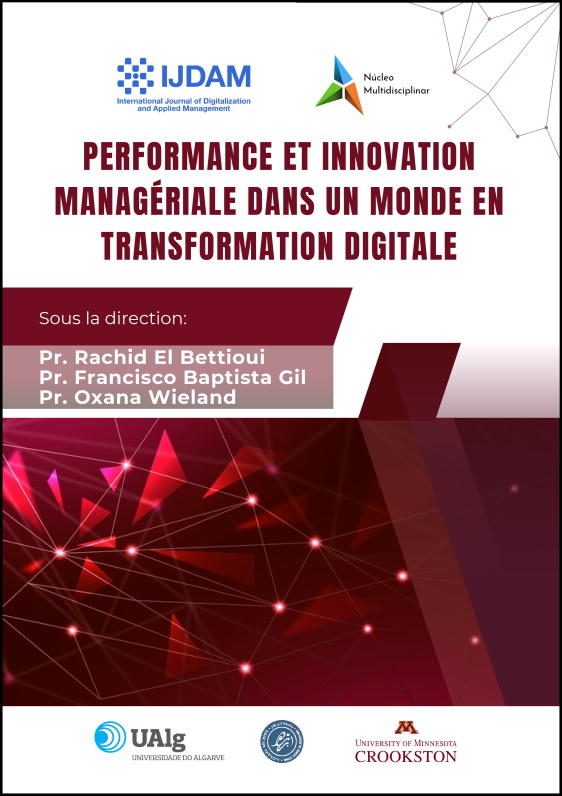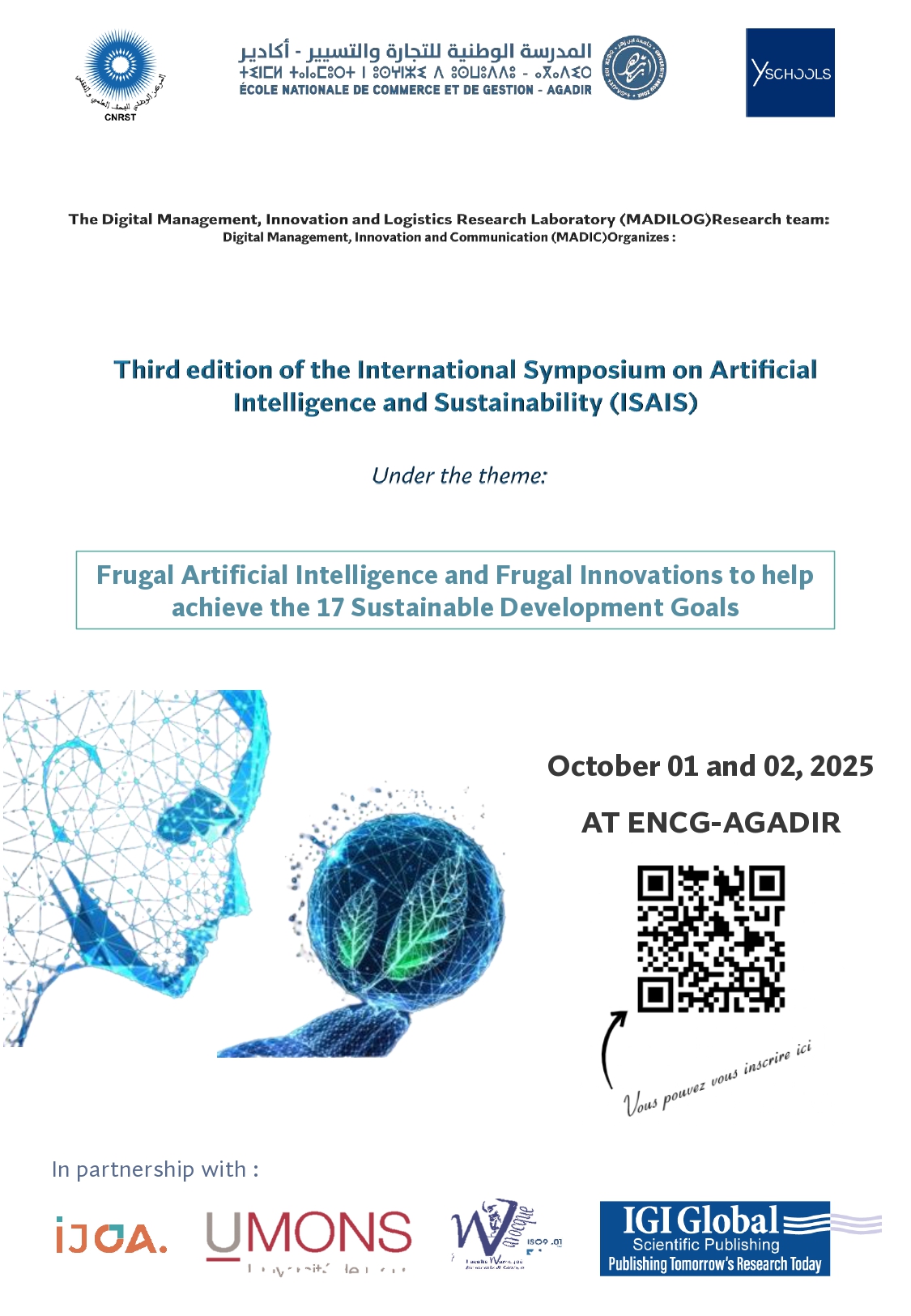Modèle intégratif pour optimiser la performance organisationnelle via le contrôle de gestion social et le système d'information des ressources humaines
DOI :
https://doi.org/10.23882/ijdam.24143Mots-clés :
Performance organisationnelle, Contrôle de gestion social, Système d'information des ressources humaines (SIRH), Automatisation des processus RH, Engagement des employésRésumé
Cet article présente un modèle conceptuel intégratif pour optimiser le management de la performance organisationnelle en s'appuyant sur deux dimensions explicatives principales : le contrôle de gestion social et les systèmes d'information des ressources humaines (SIRH). Bien que la recherche sur la performance organisationnelle soit abondante, les interactions entre les dimensions technologique et humaine demeurent peu explorées. Ce cadre repose sur des théories liées à la gestion de la performance, l’automatisation des processus RH, et la gestion du bien-être et de l'engagement des employés. L’étude analyse l’influence conjointe du contrôle de gestion social et des SIRH sur deux éléments clés : la productivité organisationnelle et la rétention des talents. Basée sur une revue approfondie de la littérature, elle montre que l’automatisation des processus RH et le suivi des performances, tout en améliorant l’efficacité, doivent être complétés par des pratiques sociales favorisant l’engagement des employés pour garantir une performance optimale. En conclusion, l’article propose une intégration harmonieuse des outils technologiques et des pratiques sociales, tout en soulignant le besoin de recherches empiriques pour valider ces résultats.
Références
Abasaheb, S. A., & Subashini, R. (2024). Enhancing HR Efficiency Through the Integration of Artificial Intelligence and Internet of Things: A Study on AI Implementation in Human Resource Management. EAI endorsed transactions on scalable information systems, 11(2), 1-11. https://doi.org/10.4108/eetsis.4208
Abuhantash, A. (2023). The Impact of Human Resource Information Systems on Organizational Performance: A Systematic Literature Review. European Journal of Business and Management Research, 8(3), 239-245. https://doi.org/10.24018/ejbmr.2023.8.3.1992
Adinew, Y. (2024). A comparative study on motivational strategies, organizational culture, and climate in public and private institutions. Current Psychology, 43(13), 11470-11492. https://doi.org/10.1007/s12144-023-05259-9
Ahmad, N. N., Zameri, S. N. M., & Mustapa, Z. (2024). Navigating Complexity of Human Resource Information System based on Institutional Theory Perspective. JMM17: Jurnal Ilmu ekonomi dan manajemen, 11(1), 79-87. https://doi.org/10.30996/jmm17.v11i1.10821
Akoyo, S. I., & Muathe, S. M. A. (2017). Towards a Theoretical Model for Human Resource Management Information Systems, Government Policy and Organizational Performance: A Research Agenda. IOSR Journal of Business and Management, 19(1), 43-53. doi: 10.9790/487X-1901034353
Al Humairah, K., Irawan, A., Ibrahim, M. B. H., Yendra, Y., & Rasyid, A. (2023). Crafting Effective HRM Strategies for Enhancing Organizational Performance and Employee Engagement. Advances in Human Resource Management Research, 1(3), 126-136. https://doi.org/10.60079/ahrmr.v1i3.183
Alzoraiki, M., Alastal, A. Y. M., Milhem, M., Ateeq, A., & Alkadash, T. M. (2024). The Role of Accounting Information Systems in Enhancing Human Resources Management Cycle. In The AI Revolution: Driving Business Innovation and Research. Cham: Springer Nature Switzerland, 1, 97-109. https://doi.org/10.1007/978-3-031-54379-1_8
Ammupriya, A., & Subrahmanyan, P. (2023). Enhancement of work engagement through HRIS adoption mediated by workplace well-being. Brazilian Journal of Operations & Production Management, 20(1), 1499-1499. https://doi.org/10.14488/BJOPM.1499.2023
Amri, A. (2024). Trends in Human Resource Management and Organizational Behavior. Economics and Digital Business Review, 5(2), 1011-1027. https://doi.org/10.37531/ecotal.v5i2.1374
Anitha, J. (2014). Determinants of employee engagement and their impact on employee performance. International journal of productivity and performance management, 63(3), 308-323. https://doi.org/10.1108/IJPPM-01-2013-0008
Arfaoui, N., Hofaidhllaoui, M., & Chawla, G. (2020). Social performance of the company: An explanation centralized on the social and technological factors. EuroMed Journal of Business, 15(1), 102-126. https://doi.org/10.1108/EMJB-03-2018-0024
Armstrong, M., & Taylor, S. (2023). Armstrong's handbook of human resource management practice: A guide to the theory and practice of people management. Kogan Page Publishers.
Aubouin-Bonnaventure, J., Chevalier, S., Lahiani, F. J., & Fouquereau, E. (2024). Well-being and performance at work: a new approach favourable to the optimal functioning of workers through virtuous organisational practices. International Journal of Organizational Analysis, 32(4), 608-623. https://doi.org/10.1108/IJOA-01-2023-3584
Awadallah, E. (2024). Advancing human and social dimensions in balanced scorecards for GCC corporations: a nuanced approach. Cogent Economics & Finance, 12(1), 2398737. https://doi.org/10.1080/23322039.2024.2398737
Bamel, U. K., Rangnekar, S., Stokes, P., & Rastogi, R. (2013). Organizational climate and managerial effectiveness: An Indian perspective. International Journal of Organizational Analysis, 21(2), 198-218. https://doi.org/10.1108/IJOA-09-2011-0514
Barney, J. (1991). Firm resources and sustained competitive advantage. Journal of management, 17(1), 99-120. https://doi.org/10.1177/014920639101700108
Batra, T. S., & Patil, R. (2023). Impact of HRIS Strategy on HRIS Effectiveness. Scholarly Research Journal for Interdisciplinary Studies, 11/77, 405-415. https://doi.org/10.5281/zenodo.8191526
Battaglia, D., Galati, F., Molinaro, M., & Pessot, E. (2023). Full, hybrid and platform complementarity: exploring the industry 4.0 technology-performance link. International Journal of Production Economics, 263, 108949. https://doi.org/10.1016/j.ijpe.2023.108949
Ben Dahhane, A., Akrich, S., Elktiri, L., & El Bettioui, R. (2024). Impact de la comptabilité analytique sur la performance financière des banques marocaines : effet modérateur des systèmes d’information. : Moderating Effect of Information Systems. IJDAM • International Journal of Digitalization and Applied Management, 1(1), 42-56. https://doi.org/10.23882/ijdam.24089
Berry, A. J., Coad, A. F., Harris, E. P., Otley, D. T., & Stringer, C. (2009). Emerging themes in management control: A review of recent literature. The British Accounting Review, 41(1), 2-20. https://doi.org/10.1016/j.bar.2008.09.001
Blackman, D., Olney, S., & Gardner, K. (2021). Governance and systems: why public sector performance research approaches are changing. Handbook on Performance Management in the Public Sector, Edward Elgar Publishing, Cheltenham, 19-27. https://doi.org/10.4337/9781789901207.00007
Bondarouk, T. V., & Ruël, H. J. M. (2009). Electronic Human Resource Management: challenges in the digital era. The International Journal of Human Resource Management, 20(3), 505-514. doi:10.1080/09585190802707235
Bondarouk, T., & Ruël, H. (2013). The strategic value of e-HRM: results from an exploratory study in a governmental organization. The International Journal of Human Resource Management, 24(2), 391-414. https://doi.org/10.1080/09585192.2012.675142
Bouquin, H. (2010). Le contrôle de gestion: contrôle de gestion, contrôle d'entreprise et gouvernance. France: Presses universitaires de France.
Bourne, M., Mills, J., Wilcox, M., Neely, A., & Platts, K. (2000). Designing, implementing and updating performance measurement systems. International journal of operations & production management, 20(7), 754-771. https://doi.org/10.1108/01443570010330739
Brudan, A., Gorski, T., Mihailoaie, C., & Pentek, B. (2023). Towards Effective Performance Management Systems: A Case Study on Integrated Performance Management Maturity Model Deployment. Timisoara Journal of Economics and Business, 16(2), 119-140. https://doi.org/10.2478/tjeb-2023-0007
Bshayreh, M. M., Qawqzeh, H. K., Al-Momany, I. A. A., Saleh, M. M. A., & Al Qallap, K. D. H. (2024). The influence of balanced scorecard perspectives on the firms’performance: evidence from the banks in the developing market. 5(2), 243-254. doi: 10.22495/cbsrv5i2art21
Cascio, W. F. (2006). The economic impact of employee behaviors on organizational performance. California Management Review, 48(4), 41-59. https://doi.org/10.1177/000812560604800401
Casini, A., Bensliman, R., Callorda Fossati, E., Degavre, F., & Mahieu, C. (2018). Is social innovation fostering satisfaction and well-being at work? Insights from employment in social enterprises providing long-term eldercare services. Voluntas: International Journal of Voluntary and Nonprofit Organizations, 29, 1244-1260. https://doi.org/10.1007/s11266-018-0001-3
Chatterjee, S. (2023). Addressing Challenges Faced by Public Organizations: The Central Role of Agility at the Federal Level During the Covid-19 Crisis. http://dx.doi.org/10.34917/37200497
Choudhary, P., & Kunte, M. (2023). Is high-performance work system making employees happy? An integrated model and research agenda for sustainable organizational growth. Employee Responsibilities and Rights Journal, 1-19. https://doi.org/10.1007/s10672-023-09451-8
Corritore, M., Goldberg, A., & Srivastava, S. B. (2020). Duality in diversity: How intrapersonal and interpersonal cultural heterogeneity relate to firm performance. Administrative Science Quarterly, 65(2), 359-394. https://doi.org/10.1177/0001839219844175
Deci, E. L., & Ryan, R. M. (2012). Self-determination theory. Handbook of theories of social psychology, 1(20), 416-436. http://digital.casalini.it/9781446269008 - Casalini id: 4912667
Deci, E. L., Olafsen, A. H., & Ryan, R. M. (2017). Self-determination theory in work organizations: The state of a science. Annual review of organizational psychology and organizational behavior, 4(1), 19-43. https://doi.org/10.1146/annurev-orgpsych-032516-113108
Deci, E. L., Ryan, R. M., Gagné, M., Leone, D. R., Usunov, J., & Kornazheva, B. P. (2001). Need satisfaction, motivation, and well-being in the work organizations of a former eastern bloc country: A cross-cultural study of self-determination. Personality and social psychology bulletin, 27(8), 930-942. https://doi.org/10.1177/0146167201278002
Dhir, S., & Shukla, A. (2019). Role of organizational image in employee engagement and performance. Benchmarking: An International Journal, 26(3), 971-989. https://doi.org/10.1108/BIJ-04-2018-0094
Domingues, P., Sampaio, P., & Arezes, P. M. (2016). Integrated management systems assessment: a maturity model proposal. Journal of Cleaner Production, 124, 164-174. https://doi.org/10.1016/j.jclepro.2016.02.103
Dorta-Afonso, D., Romero-Domínguez, L., & Benítez-Núñez, C. (2023). It’s worth it! High performance work systems for employee job satisfaction: The mediational role of burnout. International Journal of Hospitality Management, 108, 103364. https://doi.org/10.1016/j.ijhm.2022.103364
Drucker, P. F. (1999). Knowledge-worker productivity: The biggest challenge. California management review, 41(2), 79-94. https://doi.org/10.2307/41165987
Erfan, M. (2024). The Impact of Cross-Cultural Management on Global Collaboration and Performance. Advances in Human Resource Management Research, 2(2), 102-112. https://doi.org/10.60079/ahrmr.v2i2.261
Ferreira, V. C., Gomes, G., & Borini, F. M. (2023). Importance of human factors to innovation and organizational performance. Technology Analysis & Strategic Management, 1-15. https://doi.org/10.1080/09537325.2023.2293855
Florkowski, G. W. (2019). HR technologies and HR-staff technostress: an unavoidable or combatable effect?. Employee Relations: The International Journal, 41(5), 1120-1144. https://doi.org/10.1108/ER-08-2018-0214
Freeman, R. E. (1984). Strategic Management: A Stakeholder Approach. Royaume-Uni: Pitman.
Gelencsér, M., Szabó-Szentgróti, G., Kőmüves, Z. S., & Hollósy-Vadász, G. (2023). The Holistic Model of Labour Retention: The Impact of Workplace Wellbeing Factors on Employee Retention. Administrative Sciences, 13(5), 121. https://doi.org/10.3390/admsci13050121
Govaerts, N., Kyndt, E., Dochy, F., & Baert, H. (2011). Influence of learning and working climate on the retention of talented employees. Journal of workplace learning, 23(1), 35-55. https://doi.org/10.1108/13665621111097245
Greenwald, H. P. (2007). Organizations: Management without control. Sage Publications.
Grillo, F., Wiegmann, P. M., de Vries, H. J., Bekkers, R., Tasselli, S., Yousefi, A., & van de Kaa, G. (2024). Standardization: Research Trends, Current Debates, and Interdisciplinarity. Academy of Management Annals, 18(2), 788-830. https://doi.org/10.5465/annals.2023.0072
Gupta, N., & Sharma, V. (2016). Exploring employee engagement—A way to better business performance. Global Business Review, 17(3_suppl), 45S-63S. https://doi.org/10.1177/0972150916631082
Halid, H., Halim, S. N. A., & Ravesangar, K. (2022). Human resource management practices in the digital era. In Technological Challenges: The Human Side of the Digital Age, 109-158. Cham: Springer International Publishing. https://doi.org/10.1007/978-3-030-98040-5_5
Halid, H., Ravesangar, K., Mahadzir, S.L., & Halim, S.N.A. (2024). Artificial Intelligence (AI) in Human Resource Management (HRM). In: Machado, C. (eds) Building the Future with Human Resource Management. Management and Industrial Engineering. Springer, Cham, 37-70. https://doi.org/10.1007/978-3-031-52811-8_2
Hana, A., & Ridha, B. (2023). Social Capital and Organisational Performance of Social Enterprise in Tunisia: the Mediating Role of Social Innovation. International Journal of Innovation Management, 27(03n04), 2350016. https://doi.org/10.1142/S1363919623500160
Hendrickson, A. R. (2003). Human resource information systems: Backbone technology of contemporary human resources. Journal of Labor Research, 24(3), 381-394. doi:10.1007/s12122-003-1002-5
Ho, H., & Kuvaas, B. (2020). Human resource management systems, employee well-being, and firm performance from the mutual gains and critical perspectives: The well-being paradox. Human Resource Management, 59(3), 235-253. https://doi.org/10.1002/hrm.21990
Hoxha, S., & Ramadani, R. (2024). The Impact of Intrinsic Motivation on the Sustainable Extra-Role Performance with the Mediating Role of Job Engagement. Sustainability, 16(17), 7643. https://doi.org/10.3390/su16177643
Jayasuria, J. G., Lakshmi, G., Kumar, K. K., & Gayathri, S. S. (2024). A Study On Impact Of Hr Role With The Performance Of Hris-A Study On Employees Working In Sales Of Fmcg. Educational Administration: Theory and Practice, 30(5), 13362-13367. https://doi.org/10.53555/kuey.v30i5.5787
Jena, L., & Nayak, U. (2023). Organizational career development and retention of millennial employees: role of job satisfaction, organizational engagement and employee empowerment. International Journal of Organization Theory & Behavior, 26(1/2), 115-131. https://doi.org/10.1108/IJOTB-08-2022-0159
Jensen, M. C. (2002). Value Maximization, Stakeholder Theory, and the Corporate Objective Function. Business Ethics Quarterly, 12(2), 235-256. https://doi.org/10.2307/3857812
Jensen, M.C., Meckling, W.H. (1979). Theory of the Firm: Managerial Behavior, Agency Costs, and Ownership Structure. In: Brunner, K. (eds) Economics Social Institutions. Rochester Studies in Economics and Policy Issues, 1, 163-231. Springer, Dordrecht. https://doi.org/10.1007/978-94-009-9257-3_8
Téléchargements
Publiée
Comment citer
Numéro
Rubrique
Licence
(c) Tous droits réservés Samir MIRDASSE 2025

Ce travail est disponible sous licence Creative Commons Attribution - Pas d’Utilisation Commerciale 4.0 International.



 Portugal
Portugal











